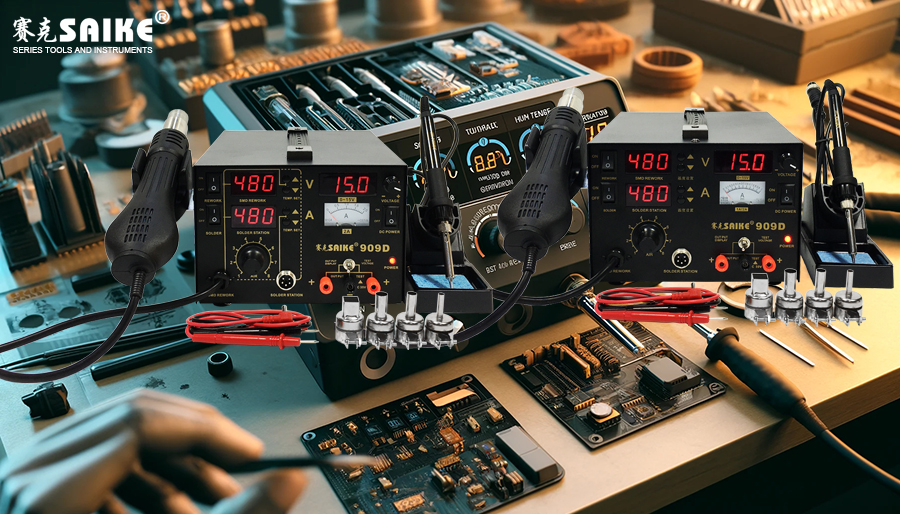
SK-YJ000RFSHY-KP 100021
Temperature adjustment of the soldering station is a crucial aspect of the soldering process, as proper temperature setting directly affects soldering quality and efficiency. Different temperatures have significant impacts on soldering results. This article will detail the methods of temperature adjustment for soldering stations and the specific effects of various temperatures on soldering outcomes.
I. Methods of Temperature Adjustment for Soldering Stations
Soldering stations are typically equipped with temperature adjustment features, allowing operators to adjust the temperature of the heating element as needed. Here are common methods of temperature adjustment:
1.Digital Display and Adjustment
– Operating Instructions:
a.Power on: Press the power button to activate the soldering station, and the display screen will light up.
b.Set temperature: Press the temperature button to enter temperature setting mode, rotate the temperature adjustment knob to set the desired temperature, and the display screen will show the set value in real-time.
c.Confirm settings: Press the confirm button, and the soldering station will start heating to the set temperature.
– Advantages: Precise setting, intuitive operation, suitable for soldering tasks that require precise temperature control.
2.Analog Adjustment Knob
– Operating Instructions:
a.Power on: Press the power button to start the soldering station.
b.Knob adjustment: Rotate the analog adjustment knob, and the pointer or marker will indicate the current set temperature.
– Advantages: Simple operation, suitable for quick temperature adjustments.
3.Preset Temperature Function
– Operating Instructions:
a.Power on: Press the power button to activate the soldering station.
b.Select preset: Press the mode button to choose a preset temperature mode (e.g., low, medium, and high settings).
c.Confirm selection: Press the confirm button, and the soldering station will heat to the preset temperature.
– Advantages: Quick switching between commonly used temperatures, suitable for jobs that require frequent temperature changes.
II. Impact of Different Temperatures on Soldering Effects
1.Low Temperature (< 250℃)
– Applicable Scenarios: Low-temperature soldering is suitable for heat-sensitive components, such as plastic-packaged integrated circuits and small SMD components.
– Soldering Effects:
– Advantages: Reduces the risk of component overheating and protects heat-sensitive materials.
– Disadvantages: Slow melting of solder, potentially weaker solder joints, and longer soldering time required.
2.Medium Temperature (250℃ – 350℃)
– Applicable Scenarios: Most conventional soldering tasks, such as through-hole components and most SMD components.
– Soldering Effects:
– Advantages: Moderate solder melting speed, strong solder joints, suitable for most soldering tasks.
– Disadvantages: Potential overheating risk for some extremely heat-sensitive components.
3.High Temperature (> 350℃)
– Applicable Scenarios: Soldering large solder joints or tasks requiring quick soldering, such as heat sinks or metal case connections.
– Soldering Effects:
– Advantages: Rapid solder melting, improved soldering efficiency, and very strong solder joints.
– Disadvantages: Prone to component overheating and damage, potential for cold solder joints or pad lifting, especially when soldering small components.
III. Impact of Temperature on Different Solders
Different types of solders require different temperatures to achieve optimal soldering results:
1.Leaded Solder (Sn60Pb40)
– Melting Point: Approximately 183℃.
– Recommended Temperature: 250℃ – 300℃.
– Soldering Effects: Traditional solder with good fluidity, suitable for soldering most electronic components.
2.Lead-Free Solder (Sn96.5Ag3Cu0.5)
– Melting Point: Approximately 217℃.
– Recommended Temperature: 320℃ – 350℃.
– Soldering Effects: Environmentally friendly solder suitable for modern electronic products, requiring higher temperatures.
3.Low-Temperature Solder (Sn42Bi58)
– Melting Point: Approximately 138℃.
– Recommended Temperature: 180℃ – 210℃.
– Soldering Effects: Suitable for heat-sensitive components, but solder joints may have lower strength.
IV. Precautions for temperature control
1.Avoid excessively high temperatures: excessively high temperatures can cause solder joints to burn, solder pads to fall off, and components to be damaged. An appropriate temperature should be selected based on specific components and solder.
2.Avoid prolonged heating: Even at a suitable temperature, prolonged heating may cause component overheating and damage. It is recommended to complete the operation in a timely manner during the soldering process.
3.Temperature calibration: Regularly calibrate the soldering station temperature controller to ensure the accuracy of temperature settings. Calibration can be performed using a thermometer or temperature probe.
4.Good ventilation: During high-temperature soldering, ensure good ventilation in the operating environment to avoid harmful smoke accumulation.
V. Conclusion
Proper adjustment of soldering station temperature is crucial for soldering results. By understanding the impact of different temperatures on soldering results, the most suitable temperature can be selected for operation, ensuring soldering quality and efficiency. Meanwhile, regular calibration and inspection of the soldering station temperature controller, as well as maintaining good operating habits, can effectively prevent overheating damage and other soldering issues. It is hoped that the temperature adjustment methods and suggestions provided in this article can help electronic maintenance personnel better master soldering techniques and improve work quality.


